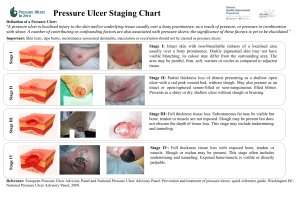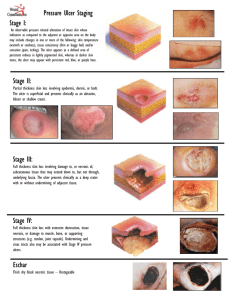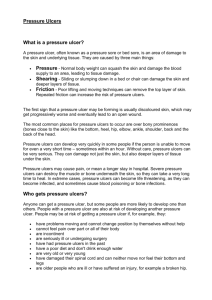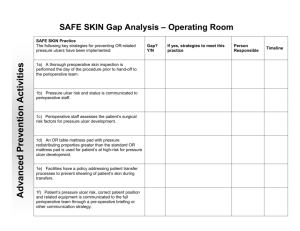The Question of Pressure Ulcer Prevention for Carers
advertisement
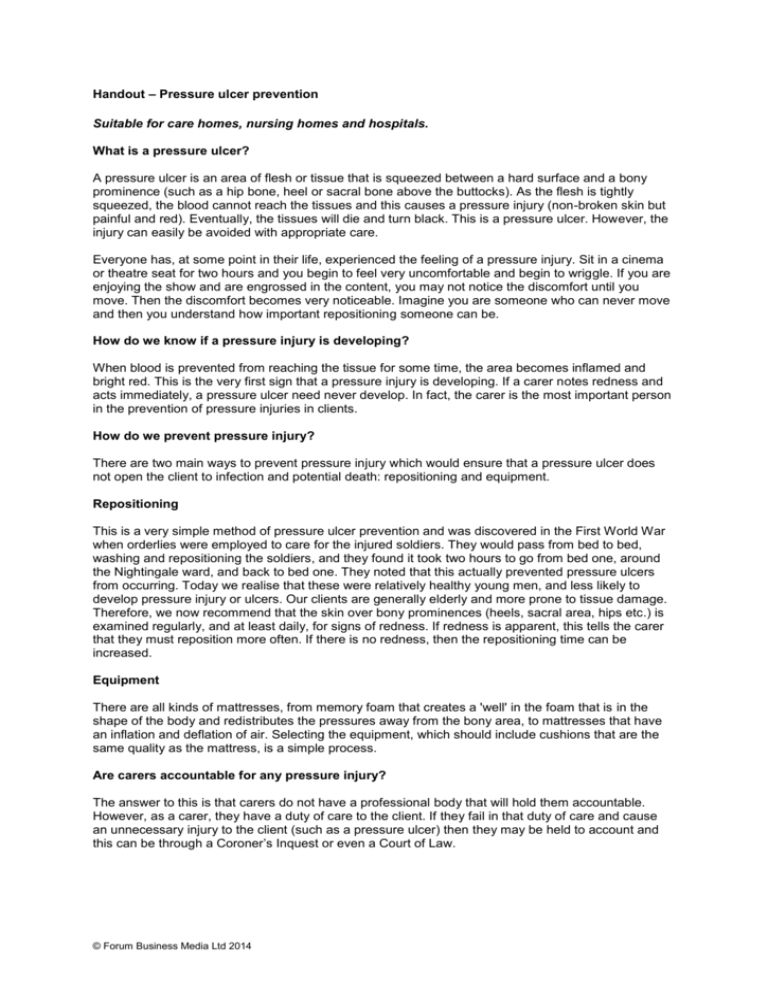
Handout – Pressure ulcer prevention Suitable for care homes, nursing homes and hospitals. What is a pressure ulcer? A pressure ulcer is an area of flesh or tissue that is squeezed between a hard surface and a bony prominence (such as a hip bone, heel or sacral bone above the buttocks). As the flesh is tightly squeezed, the blood cannot reach the tissues and this causes a pressure injury (non-broken skin but painful and red). Eventually, the tissues will die and turn black. This is a pressure ulcer. However, the injury can easily be avoided with appropriate care. Everyone has, at some point in their life, experienced the feeling of a pressure injury. Sit in a cinema or theatre seat for two hours and you begin to feel very uncomfortable and begin to wriggle. If you are enjoying the show and are engrossed in the content, you may not notice the discomfort until you move. Then the discomfort becomes very noticeable. Imagine you are someone who can never move and then you understand how important repositioning someone can be. How do we know if a pressure injury is developing? When blood is prevented from reaching the tissue for some time, the area becomes inflamed and bright red. This is the very first sign that a pressure injury is developing. If a carer notes redness and acts immediately, a pressure ulcer need never develop. In fact, the carer is the most important person in the prevention of pressure injuries in clients. How do we prevent pressure injury? There are two main ways to prevent pressure injury which would ensure that a pressure ulcer does not open the client to infection and potential death: repositioning and equipment. Repositioning This is a very simple method of pressure ulcer prevention and was discovered in the First World War when orderlies were employed to care for the injured soldiers. They would pass from bed to bed, washing and repositioning the soldiers, and they found it took two hours to go from bed one, around the Nightingale ward, and back to bed one. They noted that this actually prevented pressure ulcers from occurring. Today we realise that these were relatively healthy young men, and less likely to develop pressure injury or ulcers. Our clients are generally elderly and more prone to tissue damage. Therefore, we now recommend that the skin over bony prominences (heels, sacral area, hips etc.) is examined regularly, and at least daily, for signs of redness. If redness is apparent, this tells the carer that they must reposition more often. If there is no redness, then the repositioning time can be increased. Equipment There are all kinds of mattresses, from memory foam that creates a 'well' in the foam that is in the shape of the body and redistributes the pressures away from the bony area, to mattresses that have an inflation and deflation of air. Selecting the equipment, which should include cushions that are the same quality as the mattress, is a simple process. Are carers accountable for any pressure injury? The answer to this is that carers do not have a professional body that will hold them accountable. However, as a carer, they have a duty of care to the client. If they fail in that duty of care and cause an unnecessary injury to the client (such as a pressure ulcer) then they may be held to account and this can be through a Coroner’s Inquest or even a Court of Law. © Forum Business Media Ltd 2014 Can a client die from pressure injury? A pressure injury is unlikely to cause death, whereas a pressure ulcer is very likely to cause death. So the answer to this is, yes, a client can die from a pressure ulcer which follows the original injury to the skin. A researcher (Baxter, C. R. (1994), ‘Immunologic reactions in chronic wounds’, American Journal of Surgery, 167:12S–14S) found that 67% of patients with a pressure ulcer who were hospitalised would die compared with 15% of at-risk patients without pressure ulcers. A pressure ulcer can create a poison that travels around the body and damages organs such as kidneys. The client is often frail and the poison will lead to death. This is unacceptable as 95% of pressure injuries are totally avoidable. How many people develop pressure ulcers? The NHS (http://www.nhs.uk/conditions/Pressure-ulcers/Pages/Introduction.aspx) estimates that just under half a million people in the UK will develop at least one pressure ulcer in any given year. This is usually people with an underlying health condition. For example, around 1 in 20 people who are admitted to hospital with an acute (sudden) illness will develop a pressure ulcer. How can I find out more about pressure ulcers and their prevention? There are several excellent websites that any person caring for a client at risk of pressure injury should be familiar with: National Institute for Clinical Excellence: www.nice.org.uk/guidance/index.jsp?action=download&o=29887 www.judy-waterlow.co.uk/ Institute for Healthcare Improvement: www.ihi.org/IHI/Programs/Campaign/PressureUlcers.htm Royal College of Nursing: www.rcn.org.uk/development/practice/clinicalguidelines/pressure_ulcers These websites will provide you with a more in-depth description of pressure ulcers and how to prevent them. Conclusion Pressure ulcers are preventable and there are different types of equipment that will promote the health of the skin and prevent the pressure injury that can eventually lead to death. © Forum Business Media Ltd 2014




